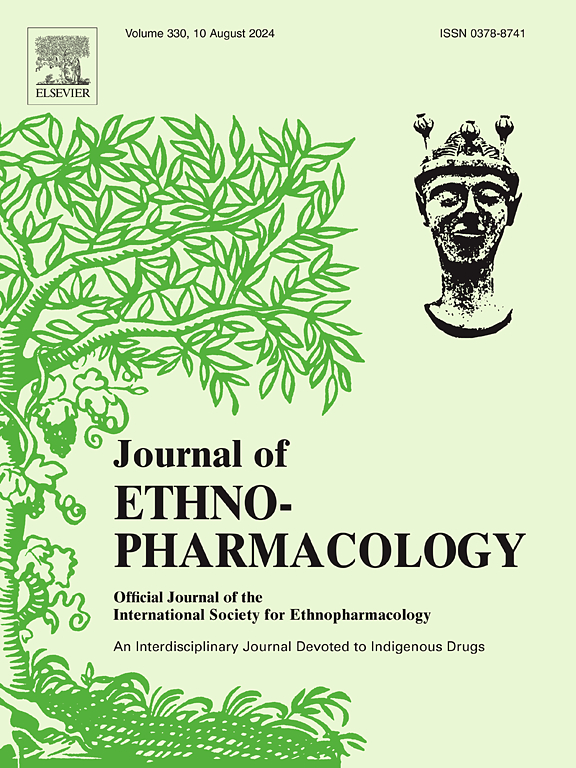Dendrobium officinale extract alleviates aging-induced kidney injury by inhibiting oxidative stress via the PI3K/Akt/Nrf2/HO-1 pathway
IF 5.4
2区 医学
Q1 CHEMISTRY, MEDICINAL
引用次数: 0
Abstract
Ethnopharmacological relevance
Dendrobium officinale Kimura et Migo (D. officinale), a staple in Traditional Chinese Medicine, has been utilized for centuries and is renowned for its properties in nourishing yin, tonifying the kidneys, and promoting fluid production to benefit the stomach. In recent years, modern pharmacological studies have substantiated its potential in anti-aging and renal protection, highlighting its therapeutic relevance in both traditional and contemporary contexts.
Aim of the study
This study aimed to investigate the impacts and possible mechanism of Dendrobium officinale in ameliorating aging-induced kidney injury.
Materials and methods
Antioxidant activity of Dendrobium officinale Kimura et Migo extract (DOE) were assessed using DPPH and ABTS radical scavenging methods. D-galactose (D-gal) induced kidney aging model and H2O2 induced NRK-52E cells model were established to evaluate extract of DOE pharmacodynamics in vitro and vivo. Cell viability and senescence of NRK-52E cell were detected by MTT assay and β-Galactosidase (SA-β-Gal) staining, respectively. H&E, kidney index and serum nephrotoxicity markers analysis were used to evaluate the protective effects of DOE. The concentrations of ROS, superoxide dismutase (SOD), malondialdehyde (MDA), glutathione peroxidase (GSH-Px), and catalas (CAT) were assessed both in vivo and in vitro. Utilizing network pharmacology, we identified the key chemical constituents and potential target genes of DOE. To validate the efficacy of these targets within the relevant pathways, we conducted molecular docking studies alongside western blotting and Real-time quantitative PCR analysis.
Results
DOE treatment markedly increased the viability and reduced the SA-β-Gal-positive rate of NRK-52E cells as compared to the H2O2 group. DOE significantly improved the general condition of the mice, including increased the kidney index, reduced the urinary protein concentration, the blood urea nitrogen (BUN), creatinine content (CRE) and improved kidney tissue injury. Furthermore, DOE treatment significantly increased the activities of SOD, GSH-Px and CAT, while decreased the level of MDA in vivo and in vitro. Network pharmacology and molecular docking analyses revealed that the effects of DOE are mediated by oxidative stress-associated genes and the PI3K/Akt signaling pathway. The results of experiments showed that DOE regulated the PI3K/Akt/Nrf2/HO-1 signaling pathway, decreased protein expression level of phosphorylation PI3K (p-PI3K), phosphorylation Akt (p-Akt), Nrf2 and HO-1. Moreover, similar results were found for mRNA expression levels of PI3K, Akt, Nrf2 and HO-1 after DOE treatment.
Conclusions
DOE may exert anti-oxidative stress effects through PI3K/Akt/Nrf2/HO-1 signaling pathway,to improve aging-induced kidney injury.

铁皮石斛提取物通过PI3K/Akt/Nrf2/HO-1通路抑制氧化应激减轻衰老所致肾损伤
民族药理学相关性:木村石斛(D. officinale)是中国传统医学中的一种主食,已被使用了几个世纪,以其滋阴、补肾、促进生津、益胃的特性而闻名。近年来,现代药理学研究证实了其在抗衰老和肾脏保护方面的潜力,突出了其在传统和现代背景下的治疗相关性。研究目的:探讨铁皮石斛对老年性肾损伤的改善作用及其可能机制。材料与方法:采用DPPH和ABTS自由基清除法对铁皮石斛木村et Migo提取物(DOE)的抗氧化活性进行评价。建立d -半乳糖(D-gal)诱导的肾脏衰老模型和H2O2诱导的NRK-52E细胞模型,评价DOE提取物的体外和体内药效学。采用MTT法和β-半乳糖苷酶(SA-β-Gal)染色法检测NRK-52E细胞的细胞活力和衰老情况。采用H&E、肾指数和血清肾毒性指标分析评价DOE的保护作用。在体内和体外检测各组ROS、超氧化物歧化酶(SOD)、丙二醛(MDA)、谷胱甘肽过氧化物酶(GSH-Px)和过氧化氢酶(CAT)的浓度。利用网络药理学的方法,我们确定了DOE的关键化学成分和潜在靶基因。为了验证这些靶点在相关通路中的有效性,我们进行了分子对接研究,同时进行了western blotting和Real-time定量PCR分析。结果:与H2O2组相比,DOE可显著提高NRK-52E细胞活力,降低SA-β- gal阳性率。DOE显著改善了小鼠的一般状况,包括增加肾脏指数,降低尿蛋白浓度、血尿素氮(BUN)、肌酐含量(CRE),改善肾脏组织损伤。此外,DOE处理显著提高了体内和体外SOD、GSH-Px和CAT的活性,降低了MDA的水平。网络药理学和分子对接分析显示,DOE的作用是由氧化应激相关基因和PI3K/Akt信号通路介导的。实验结果显示,DOE调控PI3K/Akt/Nrf2/HO-1信号通路,降低磷酸化PI3K (p-PI3K)、磷酸化Akt (p-Akt)、Nrf2和HO-1蛋白表达水平。此外,DOE治疗后PI3K、Akt、Nrf2和HO-1 mRNA表达水平也有相似的结果。结论:DOE可能通过PI3K/Akt/Nrf2/HO-1信号通路发挥抗氧化应激作用,改善衰老性肾损伤。
本文章由计算机程序翻译,如有差异,请以英文原文为准。
求助全文
约1分钟内获得全文
求助全文
来源期刊

Journal of ethnopharmacology
医学-全科医学与补充医学
CiteScore
10.30
自引率
5.60%
发文量
967
审稿时长
77 days
期刊介绍:
The Journal of Ethnopharmacology is dedicated to the exchange of information and understandings about people''s use of plants, fungi, animals, microorganisms and minerals and their biological and pharmacological effects based on the principles established through international conventions. Early people confronted with illness and disease, discovered a wealth of useful therapeutic agents in the plant and animal kingdoms. The empirical knowledge of these medicinal substances and their toxic potential was passed on by oral tradition and sometimes recorded in herbals and other texts on materia medica. Many valuable drugs of today (e.g., atropine, ephedrine, tubocurarine, digoxin, reserpine) came into use through the study of indigenous remedies. Chemists continue to use plant-derived drugs (e.g., morphine, taxol, physostigmine, quinidine, emetine) as prototypes in their attempts to develop more effective and less toxic medicinals.
 求助内容:
求助内容: 应助结果提醒方式:
应助结果提醒方式:


